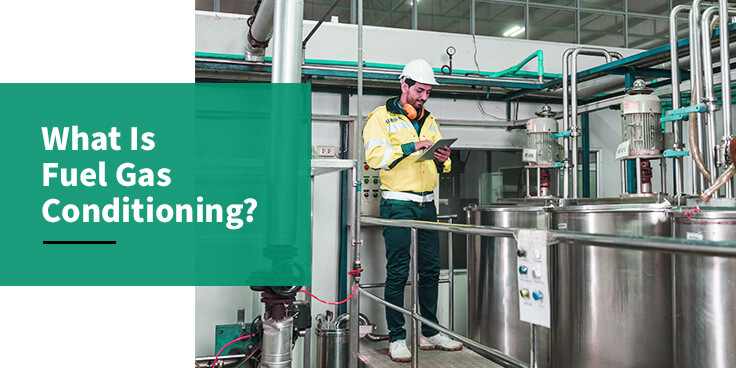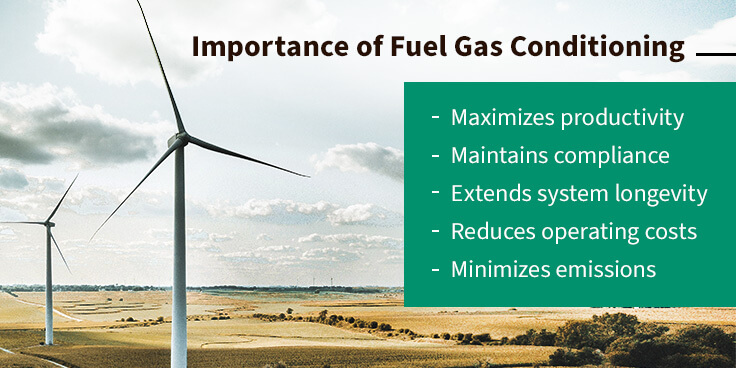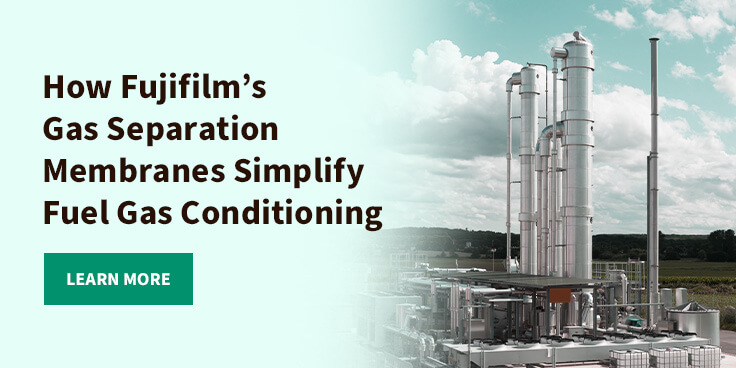
Jump to:
- What Is Fuel Gas?
- What Is Fuel Gas Conditioning?
- Importance of Fuel Gas Conditioning
- Common Fuel Gas Conditioning Methods
Fuel gas is useful in many different ways, from powering homes to providing the energy for specific manufacturing processes. But before you can use it, you must purify it through a process known as fuel gas conditioning. That process can look different depending on your specific industry and application — this post will explain what fuel gas conditioning is and the methods commonly used to accomplish it.
What Is Fuel Gas?
“Fuel gas” is a broad term that includes any natural gas-based fuel in a gaseous state under typical conditions. Fuel gas is naturally odorless, so processing often involves adding that easily distinguishable gas scent to make leaks easier to find.
There are many different potential applications for fuel gases, such as:
- Transportation vehicles
- Industrial manufacturing
- Cutting and welding
- Metal heat treatment processes
- Power generation plants
- Residential energy
Most fuel gases consist at least partially of hydrocarbons, such as propane (C3H8), acetylene (C2H2) and propylene (C3H6). Making the fuel usable requires eliminating these heavy hydrocarbons and contaminants like hydrogen sulfide (H2S) and carbon dioxide (CO2).
What Is Fuel Gas Conditioning?
Fuel gas conditioning is the process of removing contaminants from fuel gas to make it safe for use. Fuel gas conditioning removes impurities in solid, liquid and gaseous forms.
- Gas: H2S, siloxane and CO2
- Liquid: Condensed gases, heavy hydrocarbons, water, wet scrubber oil and lubrication oil
- Solid: Sand, mill scale, clay and rust
If not separated from the fuel, these contaminants could cause corrosion, buildup of chemical deposits and undesired temperature fluctuations, among other issues. These problems can compromise your fuel system and lead to loss of compliance.
When Is Fuel Gas Conditioning Used?
Any gas used in a combustion system must undergo conditioning, whether it is in a liquid or gaseous state.
Often, a fuel gas is too rich for use in a specific combustion system. In this situation, you would use fuel gas conditioning to remove heavy hydrocarbons and make the gas compatible with the manufacturer’s requirements.
Additionally, a fuel gas could collect liquid contaminants in the pipeline due to the pressure drop. Removing excess moisture and hydrocarbons is essential for ensuring fuel is safe for use.
A fuel gas skid is a compact gas conditioning system that packs multiple different process components onto one skid. The integrated design streamlines the installation process, making the skid ideal for short-term environments where component movement is frequent.
Importance of Fuel Gas Conditioning
Fuel gas conditioning is crucial for maintaining optimal system function and ensuring safe operation.
Other critical functions of fuel gas conditioning include the following.
- Maximizes productivity: Clean fuel gas burns more efficiently, increasing potential turbine power and making the turbine system more reliable.
- Maintains compliance: Burning conditioned fuel helps you meet warranty requirements and local emissions regulations.
- Extends system longevity: Fuel that burns efficiently reduces the overall operating temperature and minimizes emissions, preventing damage to the turbine and enabling your combustion system to work better for longer.
- Reduces operating costs: Clean fuel minimizes maintenance expenses and reduces the risk of unplanned downtime due to mechanical failures.
- Minimizes emissions: By separating the heavy hydrocarbons from the fuel gas, you reduce the amount of volatile organic compound emissions that can occur when burning the fuel.
In contrast, leaving fuel gas unconditioned can damage your turbines. It can also create leaks in the fuel nozzles, which can lead to explosions in extreme cases.

Common Fuel Gas Conditioning Methods
You can use several different methods to condition fuel gas. Each technique has various advantages and disadvantages that make them beneficial for specific applications.
Gas Separation Membranes
A gas separation membrane allows you to selectively separate gases without altering the contaminants’ chemical structure. Additionally, this process does not form any hydrates, so you can avoid typical issues related to liquid handling.
The process begins by feeding pressurized fuel gas into the membrane module. Heavy hydrocarbons permeate the membrane, while light hydrocarbons remain on the membrane’s high-pressure side, therefore concentrating the gas at the desired level.
Membranes are also effective for separating other contaminants, such as H2S and CO2, in addition to the heavy hydrocarbons.
Mechanical Refrigeration
A refrigeration chiller system uses circulating fluid to cool the fuel gas to below the heavy hydrocarbon’s dew point. The hydrocarbon condenses into a liquid, which you can then separate from the fuel gas. While this technique is flexible and easily controllable, mechanical refrigeration systems are less effective at high pressures due to the changing gas behavior.
Joule-Thomson (JT)
A JT gas conditioning skid removes contaminants by filtering, superheating and pressurizing the fuel gas. Raw, highly pressurized gas enters the skid through a JT valve, which leverages the cooling effect resulting from reduced pressure to condense the heavy hydrocarbons into a liquid.
In general, the greater the pressure change, the more effective the system. This method is efficient in most applications, but it involves many complex parts, making it challenging to manage for some facilities.
Amine Gas Treatment
Unlike membrane conditioning, amine gas treatment relies on chemical absorption. The process involves feeding crude fuel gas into a specialized processing unit, where the acidic CO2 molecules bond with an amine solution. This bonding creates a dissolved salt material, which then gets absorbed. The purified fuel gas flows out of the system’s product valve, while the amine solution flows into the regenerator unit for further cleaning.
Some applications use only one of the above technologies, but others may combine several methods to ensure a more thorough separation of gases.
How Fujifilm’s Gas Separation Membranes Simplify Fuel Gas Conditioning
Conditioning high-pollutant fuel gases requires enormous levels of energy when using methods like skids and amine gas treatment. At Fujifilm, we believe in providing the easiest and most productive gas treatment solutions. Our gas separation membranes offer a simple, energy-efficient alternative to conventional fuel gas conditioning methods.
Our Apura™–FG gas separation membrane has a high capacity for removing heavy hydrocarbons in natural gas conditioning applications. The modular design eliminates the need for overly complex equipment, simplifying installation and minimizing operation costs.
Additionally, you can adjust which gases you separate by changing the membrane material, allowing you to choose the most fitting membrane for your specific application.
Explore our gas membrane resources to learn more, or contact us today for information about how our products and services can benefit your business.














